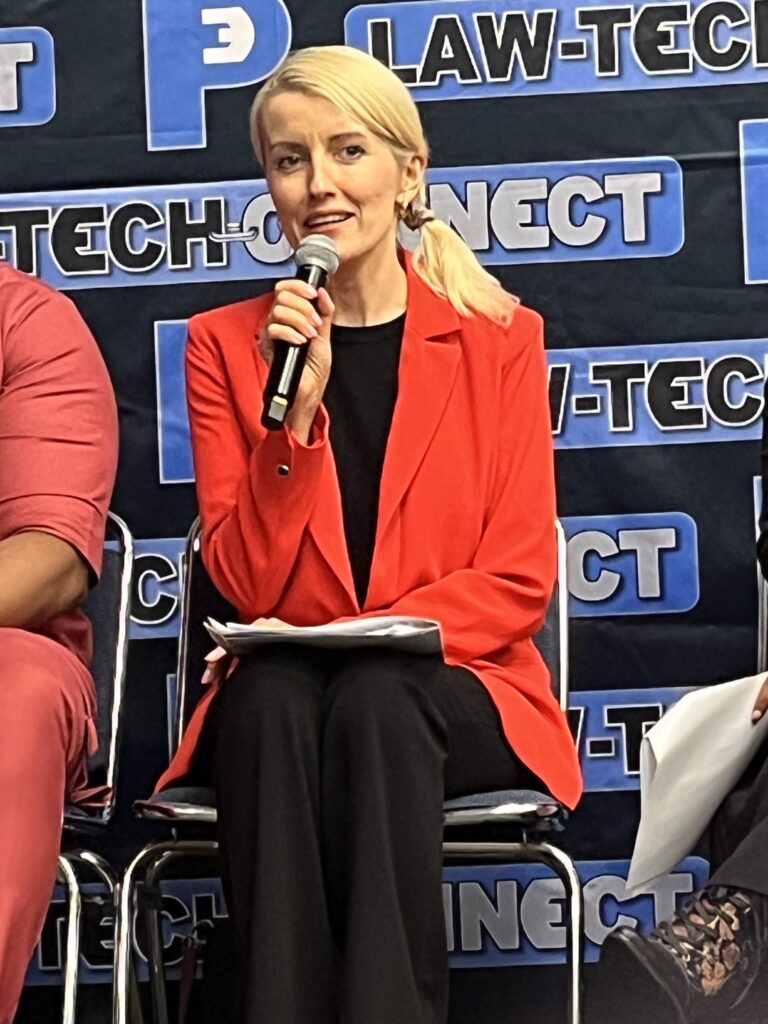By: Dawn Zoldi
Navigating the world of drone regulations can be challenging. At this year’s Law-Tech Connect, industry leaders and attorneys from Australia, Africa, Canada and Europe highlighted the international landscape of unmanned aircraft systems (UAS), with a focus on Beyond Visual Line of Sight (BVLOS) and UAS traffic management (UTM) operations. Moderated by Virginia Hiner Antypas of Akin, the panel brought together Sarah Nilsson, an attorney, pilot and law professor at Embry Riddle Aeronautical University (ERAU); Joanna Wieczorek, a Polish aviation attorney; Erika Carrasco, partner at Canadian law firm MLT Aikens; Eno Umoh of the African Drone Forum; and David Cole, CEO of FlyFreely, to discuss how different parts of the world approach the future of drones.
Worldwide Drone Regulatory Schemes: Risk and Opportunity

International drone regulation remains a patchwork of philosophies and legal frameworks, but the drive toward harmonization, and the need for clarity, unifies many efforts.
International Civil Aviation Organization (ICAO)
Nilsson observed that the ICAO forms the regulatory backbone for most member states. It provides a strategic global vision for aviation that is safe, secure and sustainable. ICAO tailors its UAS Standards and Recommended Practices (SARPs) to each nation’s context but serves as the foundational framework for collaboration (e.g., see the ICAO UAS Tool Kit).
Europe
European policy sets forth a three-tier categorization for drone operations: open, specific and certified. Open category flights are low risk and do not carry significant payloads. They typically occur within visual line of sight. Certified and specific operations enter riskier territory, often involving larger drones, complex missions or overflight of urban centers. Wieczorek explained that “the specific operations risk assessment, or SORA, is where the majority of commercial work happens.” SORA now stands at version 2.5. Further iterations are already in development to keep pace with evolving technology and use cases.
Canada and Australia
In Canada and Australia, SORA also provides the guiding reference for complex or BVLOS operations. Carrasco detailed how Canada’s approach builds on the SORA but adapts it to the nation’s vast geography and unique risk factors. “Operational volume, including flight geography, contingency volume and ground risk buffer, as the main focus for describing CONOPS,” she said.
Australia, Cole shared, is in the process of fully adopting SORA 2.5, with additional emphasis on quantitative risk modeling for the entire national airspace. Mapping air risk with scientific rigor is underway, promising to ground future regulations in real-world data. (Watch David Cole on the Dawn of Autonomy podcast).
Africa
Africa’s regulatory landscape is anything but uniform. Umoh described the diversity across 54 nations, with about 60 percent having at least baseline visual line of sight (VLOS) rules. “It’s easy to look at Africa as a block, but every country approaches airspace differently,” Umoh offered. There’s growing adoption of international standards and waivers. Umoh said collaborations between local stakeholders and foreign experts are helping to build regulatory frameworks from the ground up.
BVLOS Across Borders: Moving Past Line of Sight
Scalable global drone operations will depend on BVLOS capabilities (the ability for remotely piloted aircraft to safely operate beyond the pilot’s direct view) and regulations that enable it. While ICAO has long provided a conceptual pathway to accommodate BVLOS via its Remotely Piloted Aircraft System (RPAS) Concept of Operations (CONOPS), it is individual national regulators who must advance implementation.
U.S. BVLOS Developments
Recent months have witnessed historic change in the US, with the FAA’s Notice of Proposed Rulemaking (NPRM) published this August. Though not a subject of the panel due to timing, these developments have global implications, as the U.S. joins other leading drone markets in building out performance-based frameworks that balance innovation with safety.
This new framework marks a radical departure from the ad hoc waiver system and pivots to a scalable, performance-based approach. The NPRM introduces Parts 108 and 146 to provide a rigorous methodology for routine BVLOS operations at low altitudes. Part 108 lays out operational standards and airworthiness acceptance processes for drones; Part 146 targets certification and oversight of automated data providers, future UTM service providers central to safe BVLOS integration. BVLOS under the new US NPRM will not require all pilots to obtain FAA airman certificates. Instead, the focus is on the flight’s Operations Supervisor, a trained professional responsible for regulatory compliance and safety, and shifts ultimately responsibility for safety to the corporation. The NPRM defines operational requirements and the process for airworthiness, which will rely on consensus industry standards and robust real-world testing. (See prior AG coverage of the FAA Part 108 NPRM).
Canadian BVLOS
In Canada, the regulatory system for BVLOS flights has matured. As of April, complex level one certifications are available. This new regulatory category allows for BVLOS operations under certain scenarios, including sheltered operations and extended visual line of sight (EVLOS). Certification requires more advanced testing and ground school, which has triggered debate regarding potential industry barriers. Notably, Canada’s definition of risk, using operational weight versus speed and size, sets it apart from European methods. November will see the first flights under the new rules, according to Carrasco. (See prior AG coverage of Canadian BVLOS regulations).

BVLOS in Europe
Europe’s harmonization through EASA Regulation 945/947 is progressing, though some newer laws can be more restrictive than former local implementations. Nevertheless, companies in delivery, medical logistics and infrastructure monitoring seem to be succeeding under the European rules. Wieczorek pointed to statistics indicating over 2,600 authorizations and a million and a half pilots registered under open category rules as evidence that, for many, the regulations are workable.
Australian BVLOS
Australia takes a pragmatic “crawl, walk, run” regulatory approach. Operators begin with a certificate for VLOS operations and graduate to BVLOS through a series of incremental exemptions. This pathway is increasingly streamlined, thanks in part to the SORA framework.
Cole explained, “Having a framework is massive… there’s always a path” that allows for experimentation and innovation even as regulators refine the rules. Ambitious projects, such as remote mine inspections using “drone in a box” (DIB) technology, or uncrewed canopy flights for pipeline inspection demonstrate real BVLOS at industrial scale in the country, he said. (See prior AG coverage of Australian BVLOS).
African BVLOS
In Africa, the use of waivers and case-by-case approvals prevails. Despite higher costs for licensing, landmark achievements, such as Zipline’s 100 million delivery miles with 70% conducted in Africa, show the critical impact of flexible BVLOS policies in the medical logistics sector. Umoh shared that local solutions tailored to specific challenges are essential. “It’s more about building the system from the ground up. Assume that what works elsewhere will need adapting here.” (See prior AG coverage of BVLOS operations in Africa).
Seamless BVLOS operations demand robust, interoperable UAS Traffic Management (UTM) frameworks. ICAO’s UTM methodology, now in its fourth edition, defines principles for airspace integration, emphasizing registration, identification, communication between unmanned and manned systems, detect-and-avoid technologies and geofencing. (See also prior AG coverage of the Global UTM Association (GUTMA) assessment of UTM worldwide)
UAS Traffic Management: Scaling for the Skies
U-Space
Europe led early efforts in UTM through its U-Space regulatory package, with cities like Antwerp, Hamburg and Rotterdam piloting operational drone corridors. However, deployment has proven challenging, especially for regions lacking concentrated transportation infrastructure. The development of networks, such as Eurocontrol’s stakeholder platforms, aims to accelerate standardization and leverage experience from early implementers. (See prior AG coverage of U-Space).
Aussie UTM
Australia’s UTM progress has emphasized flexibility and technical innovation. As Cole explained, Australian and New Zealand systems allow software providers to authorize flight plans directly. This reduces friction for operators and enables rapid adaptation to airspace changes. Prototypes with DJI off-the-shelf systems highlighted hurdles with hardware integration and underscore the importance of setting performance requirements, analogous to restricting bicycles on highways by enforcing technical standards.

UTM in Africa
Africa anticipates adopting standardized UTM frameworks but maintains a “wait and see” approach. Collaboration with Korea and the expansion of training academies signal growing readiness, but most regulators remain focused on foundational licensing before tackling sophisticated traffic management. (See prior AG coverage of the Korea-Africa collaboration).
Canadian UTM
According to Carrasco, Canada moves toward UTM through multi-phase RTM (Remotely Piloted Aircraft Systems Traffic Management) trials, with Nav Canada tasked to deliver a national framework for advanced BVLOS missions by 2030. Trials emphasize rural corridors and real-world data collection, in response to the country’s unique geographic realities.
Real-World Use Cases: Regulations in Action
The actual impact of these regulatory developments is best measured by the successful deployment of advanced drone operations. In Europe, companies such as FlyingBasket are delivering packages over 25 kilograms across international borders. Despite cost challenges, enterprise operators are driving industry growth, pushing the bounds of what’s possible under SORA. (See prior AG coverage of European BVLOS drone deliveries).
Australia’s streamlined regulatory process has attracted global companies to experiment with true BVLOS missions. Mine sites and pipeline corridors, covering hundreds of kilometers, are now regularly inspected by uncrewed helicopters and solar-powered drones. The Australian Digital Airspace Characterisation (ADAC) project, led by Queensland University of Technology (QUT) in partnership with Boeing Defence Australia and FlyFreely, is a current initiative advancing airspace risk mapping for drones. It promises to further unlock territory that data shows is low risk, catalyzing innovation and better utilization of resources.
In Africa, Zipline’s partnership with governments, especially Rwanda, has revolutionized medical logistics. Operating at scale, the system delivers vital healthcare supplies safely and efficiently, setting a benchmark for BVLOS integration. The country’s flexible approach to waivers has made it a leading global example of how drones can solve real-world problems. Expansion into Nigeria and Kenya further illustrates BVLOS’s utility for the continent amid regulatory diversity.
The Flightpath Ahead: Predictions for Future Regulation

The future of global BVLOS and UTM holds both promise and complexity. Panelists uniformly anticipate a shift toward more risk-based and performance-driven regulatory models.
- Cole highlighted the air risk mapping initiative in Australia as a potential game-changer: when data supports lower risks in certain airspace, new corridors will open, while some currently available routes might be restricted due to previously unknown hazards.
- Umoh expects accelerated growth in training academies and testing corridors in Africa. “Anyone who knows me knows I work with youth and STEM development… it’s very much needed to build the next generation,” of the drone workforce, he said.
- Wieczorek remains hopeful for a return to civil applications in European countries impacted by conflict, noting that counter-drone regulation will be an essential next step for safeguarding critical infrastructure without stifling commercial aviation progress.
- Carrasco predicts that by 2030, Canada will possess mature systems, regulations, and UTM infrastructure but notes that technical standards alone are inadequate. The future will demand regulatory understanding of cyber risk, supply chain management and, above all, public social acceptance.
- Nilsson expressed hope that the U.S. would see the long-awaited BVLOS final rule. She also predicted further progress toward integrating drones into the broader airspace system, including potential modernization of the air traffic control (ATC) system to support digital, rather than solely voice-to-aircraft, communication. Her vision is a more harmonized airspace where drones and traditional aviation operate together, not in “separate pockets.”
The Law-Tech Connect expert global drone panel illuminated a worldwide movement away from bureaucratic bottlenecks toward scalable, data-driven frameworks that reflect operational realities. Waivers are fading in favor of performance-based standards and collaborative regulatory models. The path seems clear for routine BVLOS integration to unlock operations from delivery drones and medical logistics to infrastructure inspection and public safety. The next chapter of drone regulation promises to be collaborative, evolving and, perhaps most importantly, deeply interconnected across borders.

